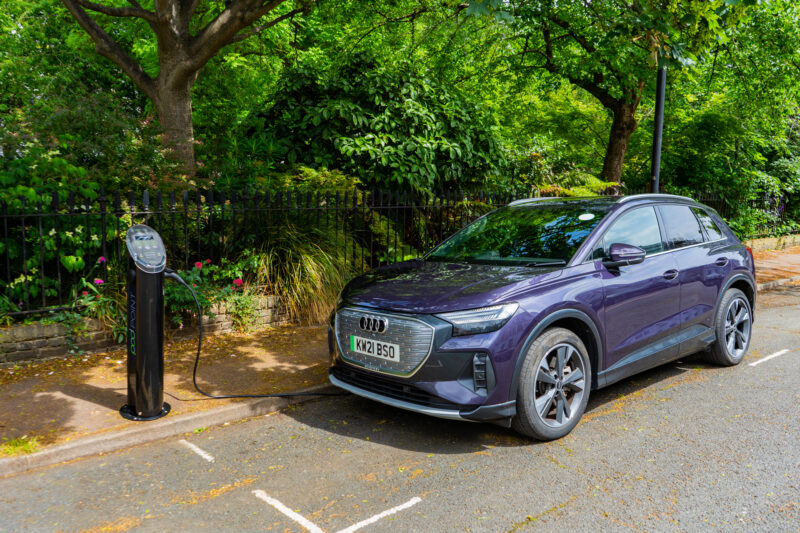An EV Driver's Guide to Tyres
A guide investigating the importance of tyres for safety and efficiency, and what to consider when purchasing tyres for an electric vehicle (EV).
Last updated: Jul 26, 2024 • 5 min read

Summary
While there’s no legal requirement to use EV-specific tyres, electric cars greatly benefit from using EV tyres. They’re designed to meet the needs of EV driving, offering better efficiency and performance.
Understanding the importance of tyres
Tyres are often overlooked when it comes to choosing a car, but they play an important role in the overall performance and experience of driving an EV. The first tyre was invented in the 19th century to increase the comfort of riding a bicycle. From there, tyres quickly popularised and became the norm for automobiles.
Today, you won’t just find tyres on cars, but on planes, bicycles and even vehicles exploring the surface of Mars.
Being the main contact point between the road and an EV, tyres need to withstand different conditions, driving habits and vehicle models. We’ll explain what that means for tyre specifications and whether it’s worth getting specialised tyres for your EV.
How does tyre condition impact your EV?
The condition of your tyres directly influences the performance of your EV. Choosing the right tyres isn't just about getting from A to B, it's about making a long-term investment into:
Fuel efficiency – Appropriate, well-maintained tyres can help you get more miles out of every charge. They’re crucial for maximising range and efficiency.
Ride comfort – Tyres significantly affect the smoothness and comfort of your drive. They can absorb road irregularities and reduce cabin noise and vibrations, making the overall driving experience more comfortable.
Safety – Good tyres provide a better grip when braking and cornering, and contribute to overall stability. Their condition can be the difference between a safe stop and a potential accident.
What to consider when purchasing new EV tyres
When it's time to purchase new tyres for your EV, keep the following in mind to ensure you're making the right choice:
Tread depth and pattern – Essential for maintaining grip, especially in wet conditions. Make sure the tread depth and pattern you choose are suitable for your driving conditions.
Pressure – Correct tyre pressure is key for efficiency and safety. You can find the right tyre pressure for your EV in the owner’s manual or the driver-side door.
Ratings – Look for tyres with a suitable rating for load, speed, measurements and efficiency to match your typical driving conditions and EV specifications.
Driving conditions – Consider the conditions you'll be driving in. Whether in a city, on motorways and A-roads or a mixture of the two, select tyres that offer the best performance and durability in your conditions.
Are EV tyres different to ICE car tyres?
Yes, EV tyres are specifically designed to withstand the additional weight that comes with the heavy battery pack. They’re built to be stronger, using different compound and sidewalls than traditional car tyres, to absorb the extra strain placed on them by electric cars. This means that EV tyres generally weigh more.
Surprisingly, EV tyres are quieter than conventional tyres, even though they’re heavier. That’s because they’re intentionally designed to reduce noise, using foam inlays or additional rubber.
However, all of this makes EV tyres more expensive. But while you’d assume that the additional strain would wear them down much faster, the opposite is true. Tyres specifically made for EVs tend to wear down at a slower rate than conventional car tyres, which makes up for the higher initial cost.
What do the numbers on tyres mean?
The numbers and letters on the sidewall of tyres indicate the size and performance specifications. Understanding these markings can help you choose tyres that fit your EV perfectly and meet your driving needs.
For example, a sidewall marking of 205/55 R16/91 V stands for:
Width – 205 is the tyre’s width in mm
Profile – 55 is the side profile as a percentage of the width
Rim – R16 indicated the wheel diameter the tyre will fit in inches
Load – 91 provides the load capacity of the tyre, in this case 615kg
Speed rating – V tells you the top speed the tyre is suitable for, in this case 149mph
What is the legal tread depth?
The legal minimum tread depth for all tyres, EV-specific or not, is 1.6mm. This ensures that your tyres maintain adequate grip, especially in wet conditions. You may notice that EV tyres have a lower tread depth when in new condition compared to conventional tyres. It helps them achieve better rolling resistance without negatively impacting performance or wear.
What is the recommended pressure for an EV tyre?
The recommended pressure for EV tyres will differ based on vehicle model and tyre size. You should follow the manufacturer's recommendations given in PSI, usually found in your manual or on a sticker inside the driver's door. Maintaining the correct pressure will contribute to better efficiency and safety, optimising range and reducing the risk of tyre damage.
How you can look after your EV tyres
Maybe you’re considering investing in a new set of EV tyres or have just bought and fitted brand new ones. There are a few simple tips you can follow to maximise the lifespan and performance of your tyres, so you can enjoy them for longer:
Maintain the right tyre pressure – Check and adjust your tyre pressure regularly according to the PSI recommended by the manufacturer
Check tread depth – Occasionally inspect your tyres to make sure you meet the 1.6mm minimum to stay safe on the road
Drive gently – Aggressive driving can wear your EV tyres out faster, so brake and accelerate gently for longevity
Avoid excess weight – Don't overload your EV, as it puts additional stress on your tyres
Navigate carefully – Avoid potholes and other hazards to prevent damage to your tyres or suspension

